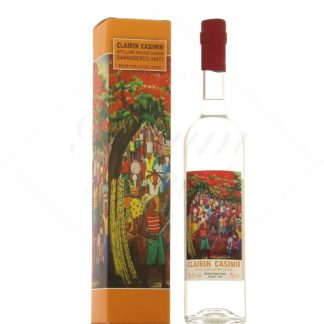Clairin (Haiti)
The history of clairin
Clairin (Kleren) is a cane brandy fromHaiti (Ayiti). Its production methods are highly artisanal, unchanged since the early days of tafia and guildive. This type of rum dominated the world in the 18th century, when Santo Domingo was the leading producer in the Caribbean. Following Haiti's independence in 1804, other producing countries evolved, refining their methods and yields, shortening fermentations and adopting increasingly efficient distillation columns. But the small-scale producers of clairin have not changed their traditions, and over 500 of them are still making it today.
Clairin was the drink of the poor, and remains a very popular spirit. It is consumed for many purposes, from medicinal to voodoo. The most traditional clairins come from almost primitive distilleries, whose simplicity has a charm all of its own. Larger distillers run slightly more modern facilities, with Creole columns. A handful of brands produce more industrial clairins, with large distillation columns.
Usually sold in bulk, it is distributed locally in cans and shared in small village grocery stores. The first bottling of clairin and first import into Europe took place in 2012. It was the importer Velier, through Luca Gargano, who discovered this exceptional spirit and decided to introduce it to the world.
A local product
Sugar cane is grown by small planters all over the country. They can be found around Cul-De-Sac, near Port-au-Price, north of Cap Haïtien, in Léogâne, on the Saint-Michel-de-l'Attalaye plateau, in the Baradères region, on the Cavaillon plain and in the Jérémie region.
Although we don't have an organic label of any kind, our cane is grown according to organic principles. The soil is prepared using ox-drawn ploughs. After being cut into 40-50 cm-long sections, the cane is buried under 15 cm of soil. Manure is then spread to fertilize it. Manual weeding is carried out 2 or 3 times a season, depending on the weather. The cane is then left to grow and ripen quietly for 18 months, before being harvested.
It goes without saying that no chemical inputs (pesticides or artificial fertilizers) are used here. Cane is planted as a mixed crop, in association with other crops such as bananas and mangoes. Harvesting is also done by hand, with a cutlass. The cane is then transported to the distillery in carts pulled by oxen or mules.
The cane varieties are diverse, and sometimes very old. In Saint-Michel-de-l'Attalaye, you'll find Farine France, Hasco, Petekoka and the rare Cristalline (non-hybrid), a noble cane of pure saccharum officinarum origin. In Léogâne and Cavaillon, Madame Meuze is the dominant variety. On the Central Plateau, Toro and Dakoun are the most popular. There are also other varieties with names as picturesque as ever, such as Saint à clou, Colembator, Pasterie, Créole and Poule poule.
The production of clairin
Clairin is made from pure cane juice or syrup. Fermentation is spontaneous, and takes place in wooden barrels (known locally as "chais"). Traditionally, the juice is not diluted, and the syrup is sometimes topped up with vinasse. Fermentation lasts at least 120 hours, and is followed by distillation in alembics or columns with a maximum of 5 or 6 trays. Direct heating is preferred in most cases.
Before bottling, traditional clairin undergoes no filtration, and is bottled at its natural alcohol content, usually around 55%.
Distilleries that use Creole columns produce clairins which are around 70 or 80%. They then gradually reduce them to 55%, to obtain the famous Clairin 22. This local name uses the alcohol measurement scale established by Cartier, where 22° corresponds to 55% alcohol on the alcohol. Gay Lussac scale. We can also find clairins 21, 20, or even 18.
The Clairin distilleries
In France, at the time of writing (early 2021), we have discovered 4 clairins imported by Velier.
Casimir
Owner: Casimir Faubert. Date of creation: 1980. Location: Baradères.
The distillery grows 50 hectares of white and red Hawaiian cane. These varieties are similar to O Tahiti, once popular in the Caribbean and now resurrected in French Polynesia.
A special feature of this clairin is the addition of sorrel leaves, lemongrass, cinnamon and sometimes ginger during the fermentation of the cane juice.
Arawaks
Owner: Fritz Vaval. Date of creation: 1946. Location: Cavaillon
20 hectares of Madame Meuze cane are grown to produce this clairin. It is distilled in a traditional still, which operates in cycles of 10 to 13 hours. Only 2 distillations are carried out per day.
Chelo
Owner: Michel Sajous milieu. Creation date: mid-20th century. Location: Saint-Michel-de-l'Attalaye.
The plantation covers 30 hectares and grows crystalline cane. The cane juice is boiled into syrup, fermented naturally, then distilled in a small still with a 6-plate column. Clearin yields 50 / 52%.
Le Rocher
Owner: Bethel Romulus. Location: village of Pignon.
Le Rocher clairin is produced using ancient methods. A cane syrup is made, so that it can be stored and distilled throughout the year. For fermentation, around 30% vinasse is added, in the manner of Jamaican high esters or grand arôme rums.
The other clairins
After producing his first limited-edition clairin blends for the World Clairin Championships (cocktail competitions organized to promote clairin), Luca Gargano has created a perennial reference, called Clairin Communal. This is a blend of the 4 clairins mentioned above.
Ageing experiments have also been carried out, with different types of cask, in the Clairins Ansyen range. Finally, the Boukman brand offers a "Kleren Tranpé", a "botanical rum" which is in fact a kind of arranged clairin. There are many soaked clairins in Haiti. They are part of popular culture, and come in a variety of recipes, for a wide range of uses. Read less















